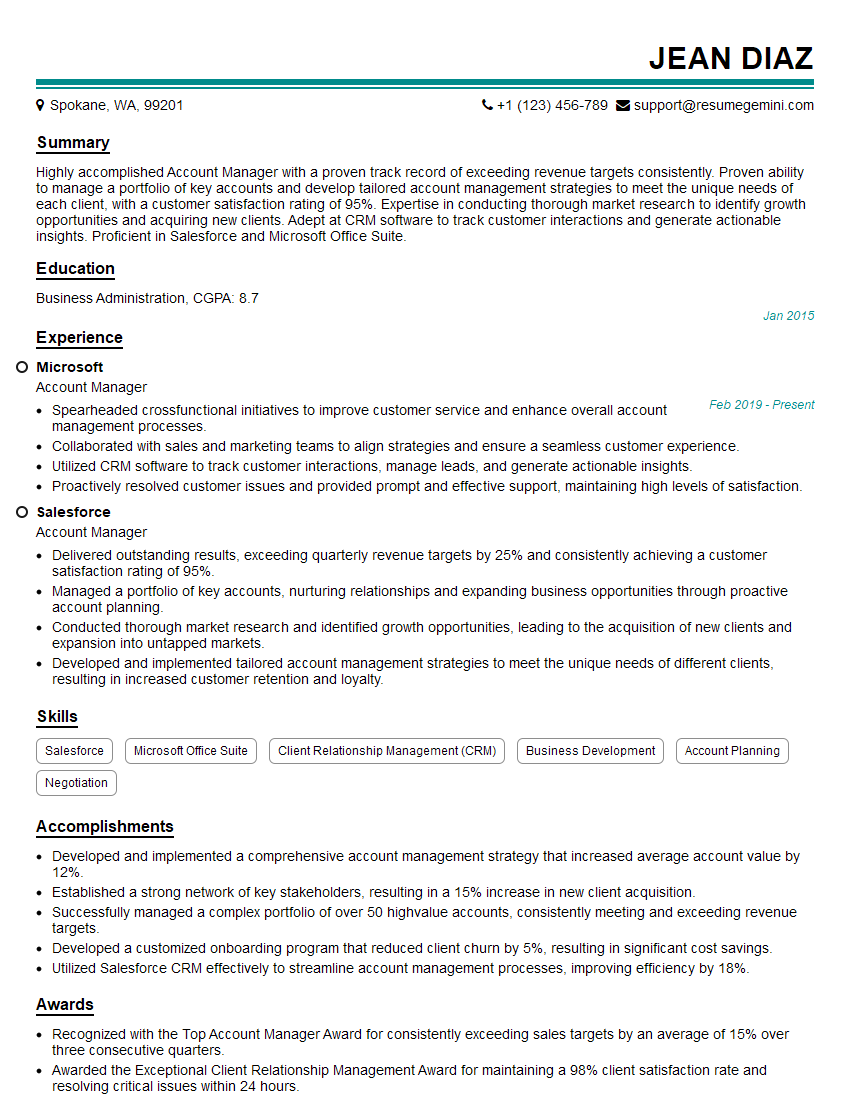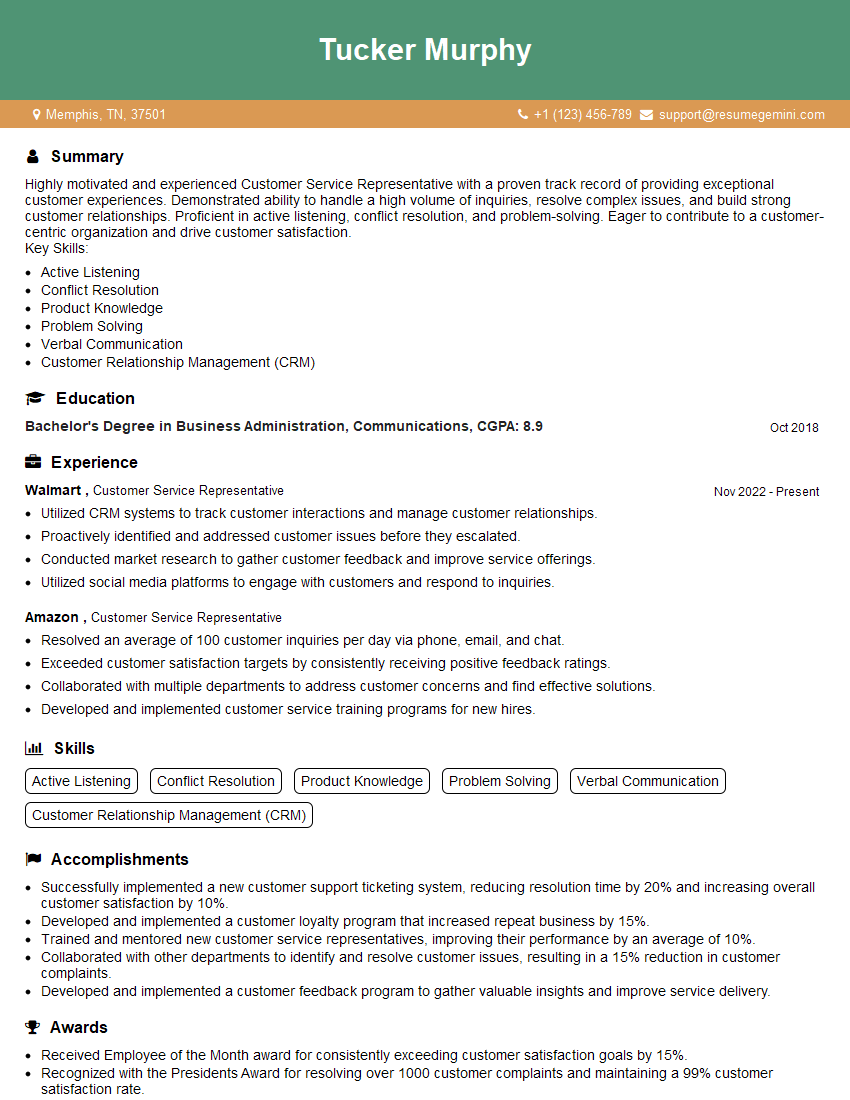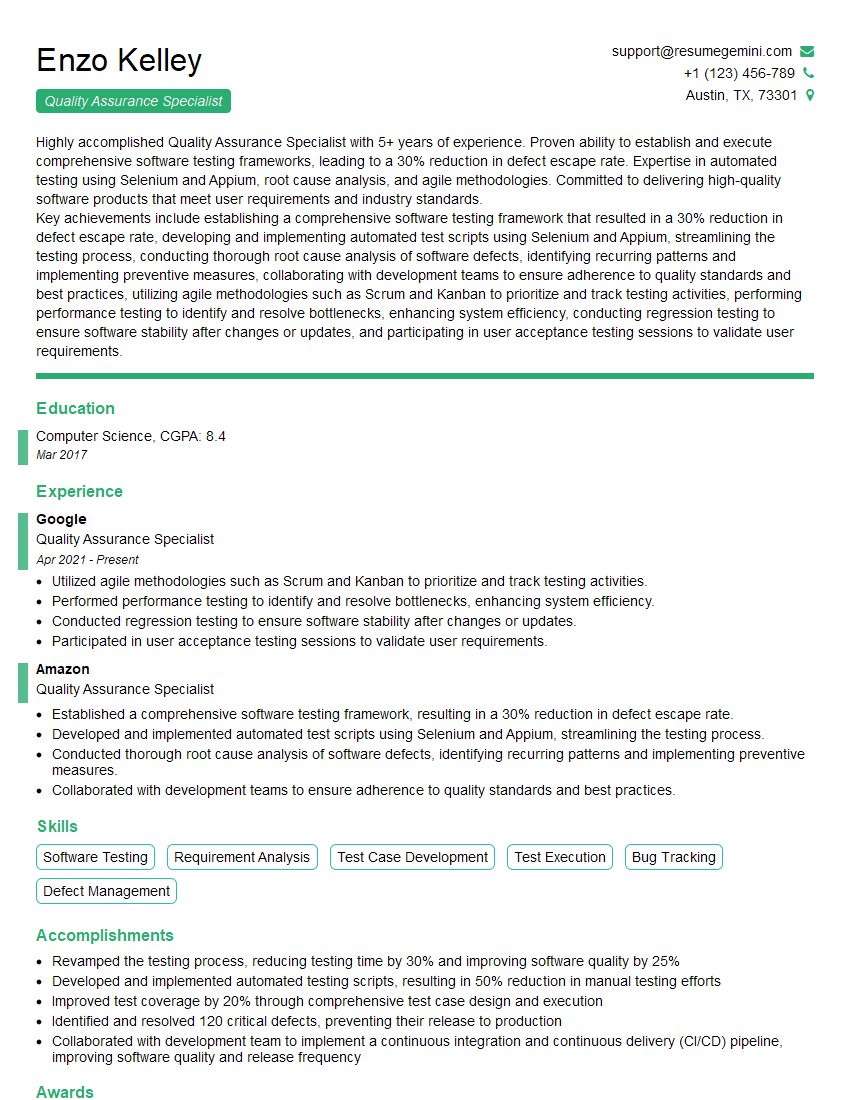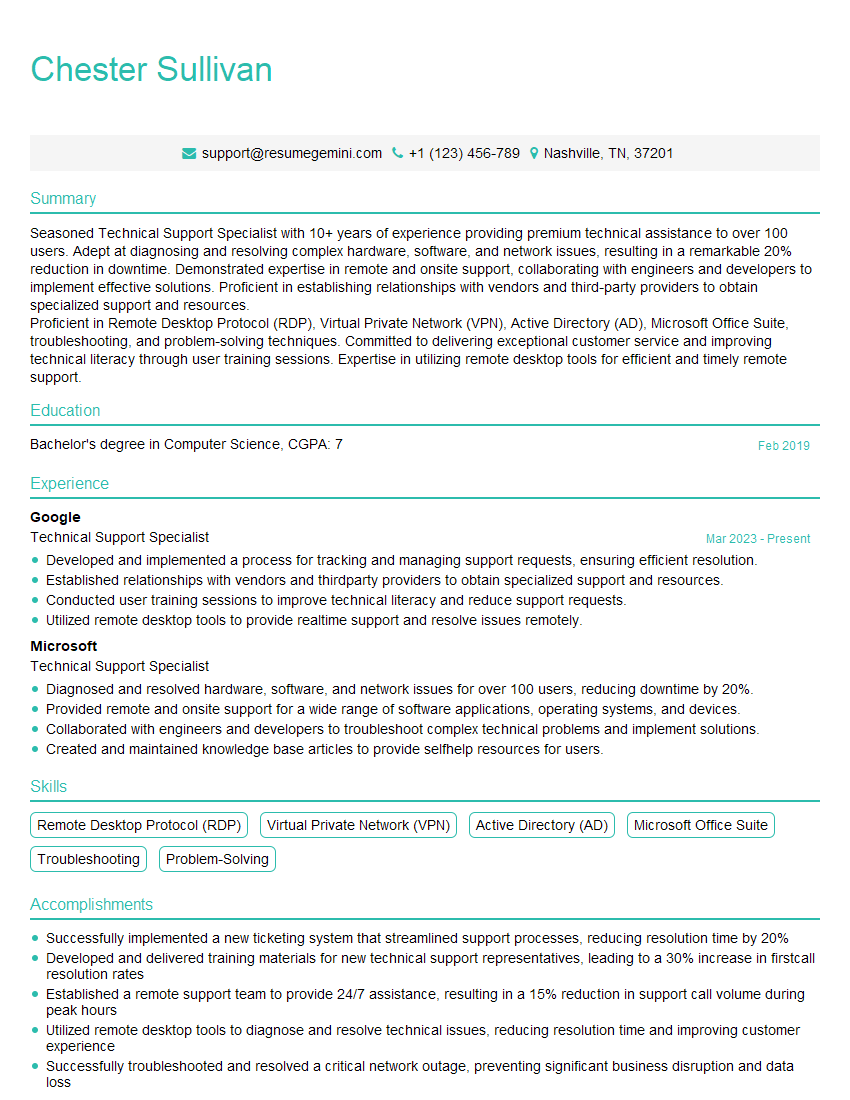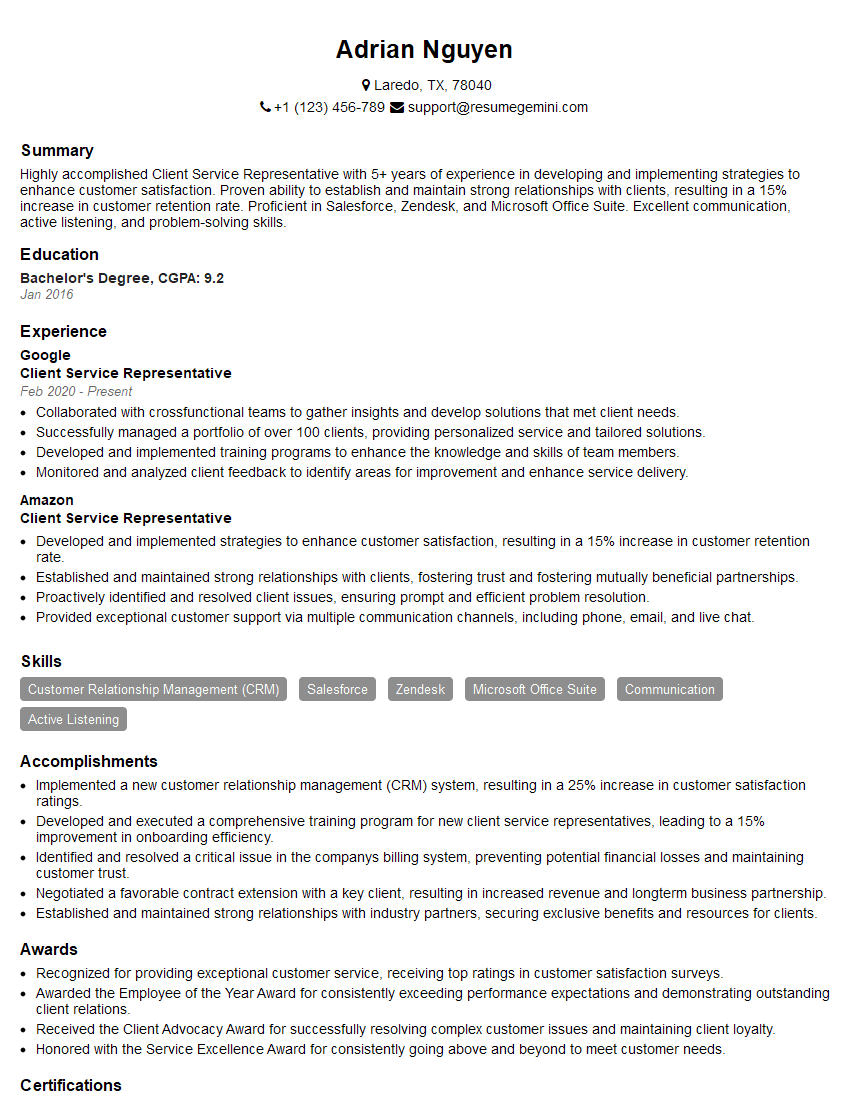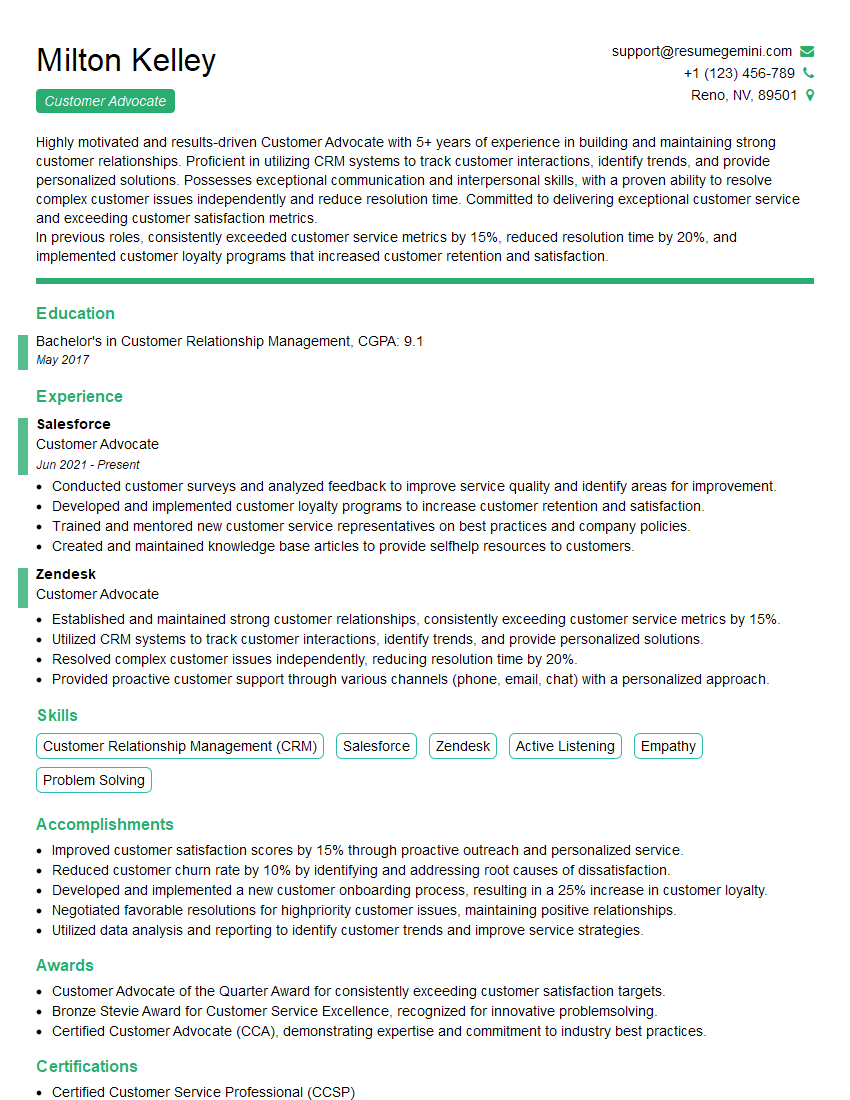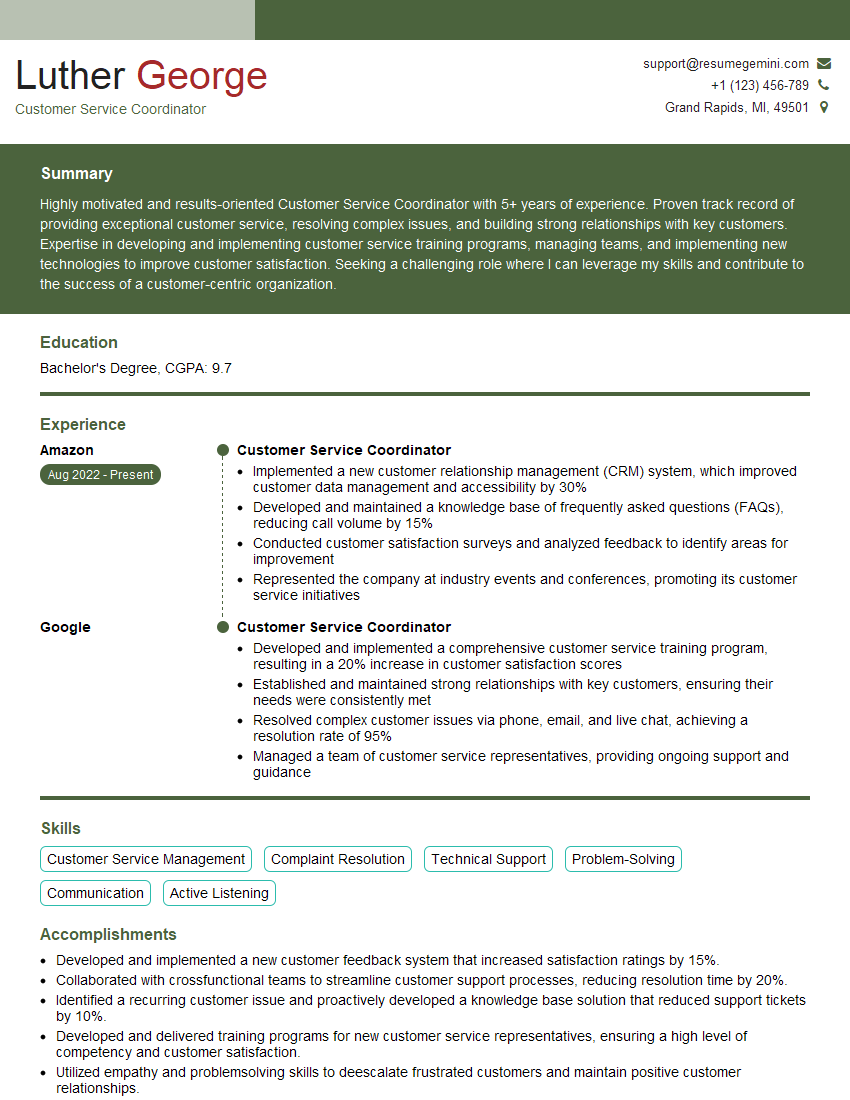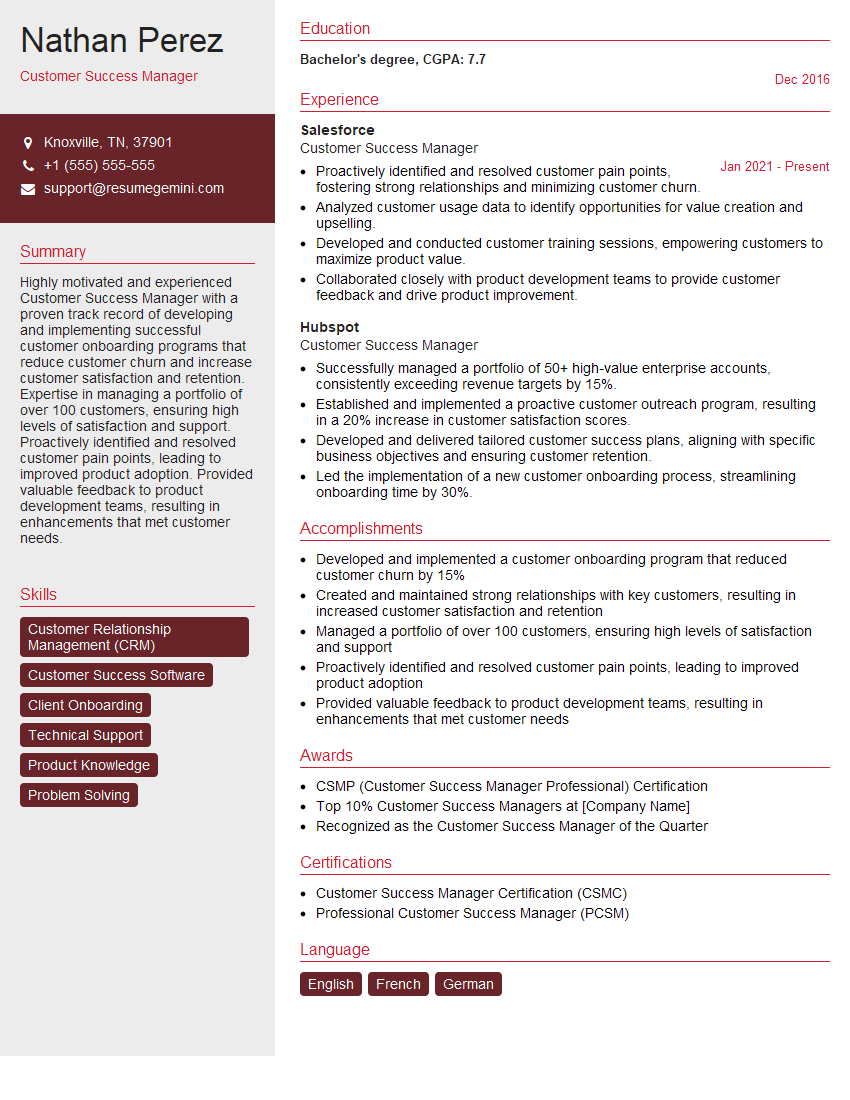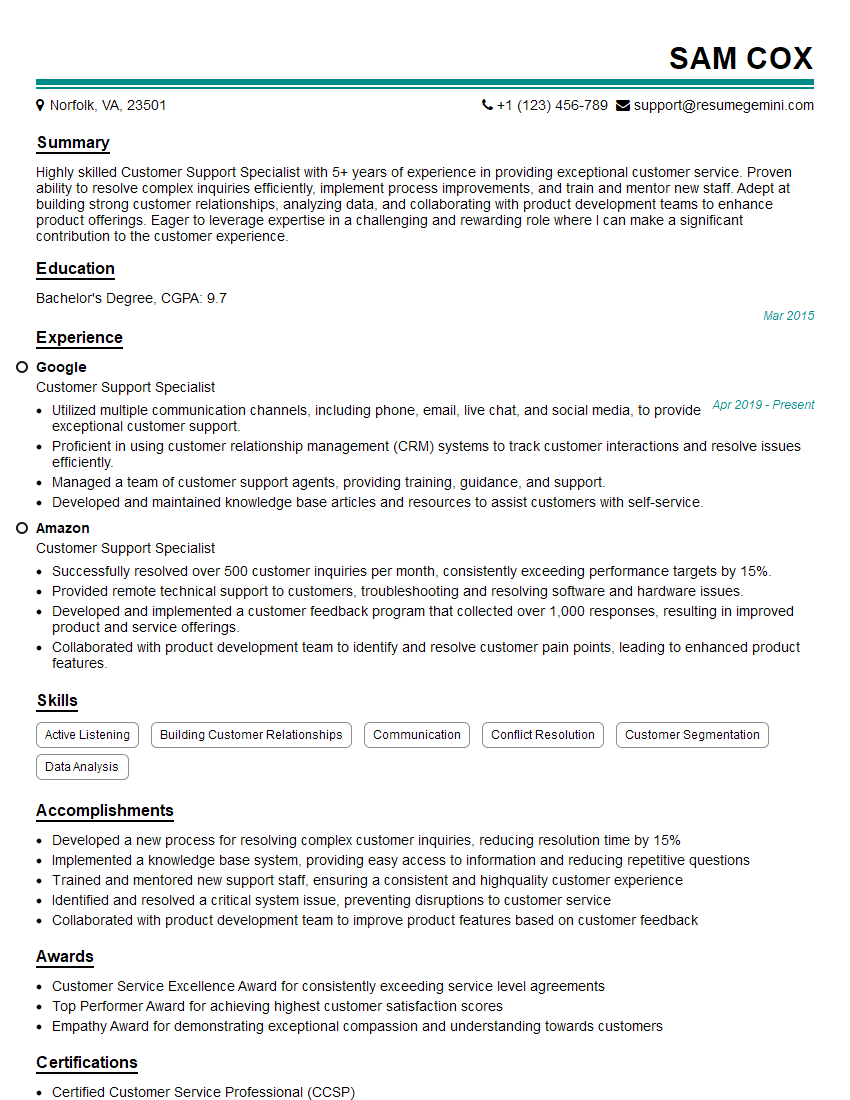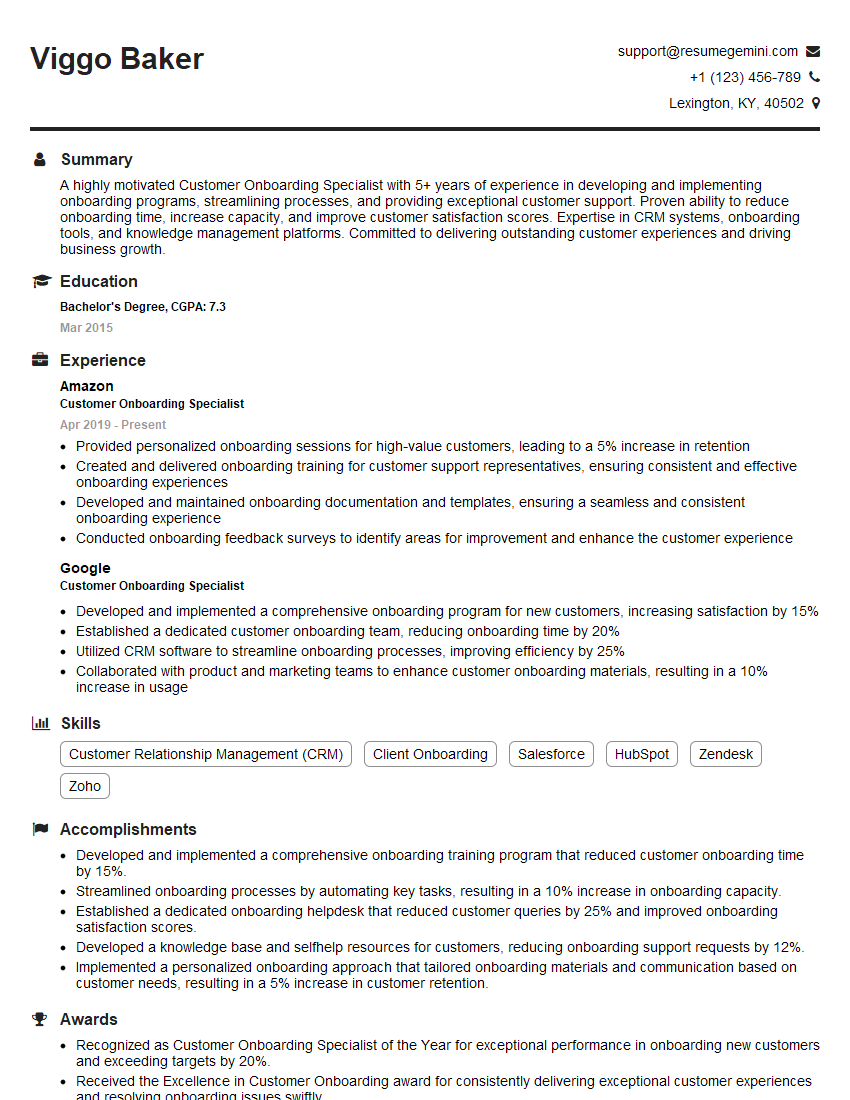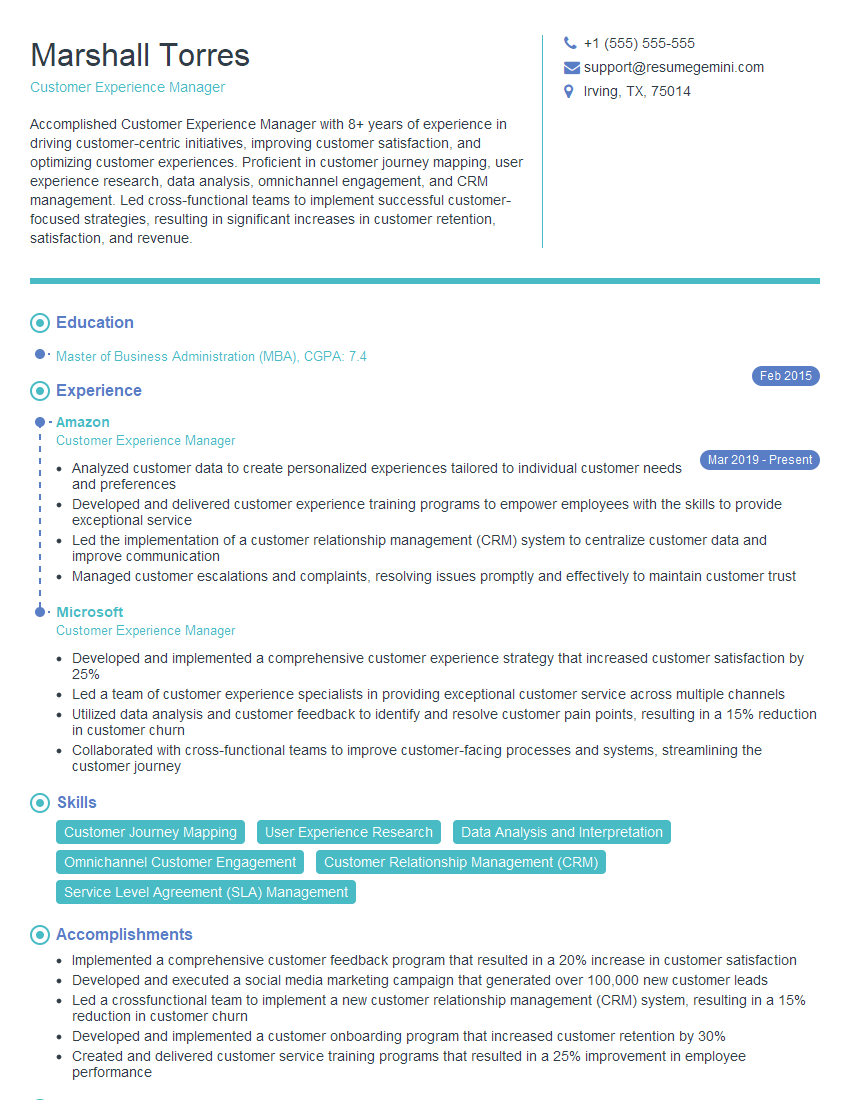Cracking a skill-specific interview, like one for Resolving Customer Complaints, requires understanding the nuances of the role. In this blog, we present the questions you’re most likely to encounter, along with insights into how to answer them effectively. Let’s ensure you’re ready to make a strong impression.
Questions Asked in Resolving Customer Complaints Interview
Q 1. Describe your process for handling a highly escalated customer complaint.
Handling a highly escalated customer complaint requires a calm, empathetic, and systematic approach. My process begins with active listening to fully understand the customer’s frustration and the specifics of their complaint. I acknowledge their feelings and validate their concerns, even if I don’t necessarily agree with their perspective. This sets a foundation for de-escalation.
Next, I move into problem-solving mode. This involves gathering all relevant information, including any previous interactions, order details, or relevant documentation. I’ll then outline possible solutions, keeping the customer involved in the decision-making process whenever possible. Transparency is key here; I clearly explain the steps I’m taking and the expected timeframe for resolution.
For extremely escalated situations, I might involve a supervisor or manager to provide additional support and resources, ensuring a timely and effective resolution. Finally, I follow up with the customer to confirm their satisfaction and ensure the issue is fully resolved. A sincere apology, even if the company wasn’t directly at fault, goes a long way in restoring trust.
Q 2. How do you prioritize multiple customer complaints simultaneously?
Prioritizing multiple customer complaints involves a combination of urgency and impact. I utilize a system that considers several factors:
- Urgency: Complaints involving immediate safety concerns, significant financial losses, or severe service disruptions take precedence.
- Impact: Complaints that affect a large number of customers or have the potential for significant negative publicity are prioritized higher.
- Severity: The level of customer distress and the complexity of the issue are considered. A highly agitated customer with a simple issue might require faster attention than a calm customer with a more complex problem.
I often use a ticketing system or CRM to manage and track these complaints, assigning priority levels and due dates to ensure timely resolution. This allows me to efficiently juggle multiple requests while maintaining a focus on providing excellent customer service.
Q 3. What techniques do you use to de-escalate an angry customer?
De-escalating an angry customer relies heavily on empathy and active listening. I start by letting the customer vent without interruption (unless the conversation becomes abusive or threatening). I use verbal cues like, “I understand your frustration,” or “I can see why you’re upset.” My goal isn’t to argue or defend, but to acknowledge their feelings.
Once they’ve had a chance to express themselves, I summarize their concerns to ensure I understand the situation correctly. This shows I’m paying attention and taking their complaint seriously. I then propose concrete steps to address their concerns, outlining a clear path to resolution. Maintaining a calm and respectful tone throughout the interaction is crucial. In some cases, offering a small concession, such as a discount or expedited service, can help smooth things over.
Q 4. How do you identify the root cause of a customer complaint?
Identifying the root cause of a customer complaint requires thorough investigation. I start by gathering all available information from the customer, including detailed descriptions of the problem, any error messages, and steps taken to try and resolve it. I then analyze this information, looking for patterns or common threads.
This might involve reviewing internal documentation, such as system logs, product specifications, or training materials. If necessary, I may consult with colleagues from other departments, such as technical support or product development, to get different perspectives and expertise. Once I’ve identified a potential root cause, I’ll test my hypothesis to ensure my understanding is accurate before proposing a solution.
For example, if multiple customers report the same software bug, the root cause is likely a flaw in the software itself, rather than individual user error. Careful analysis, coupled with collaboration, is essential for effective root cause identification.
Q 5. Explain your experience using CRM software to track and resolve customer issues.
I have extensive experience using CRM (Customer Relationship Management) software to manage and resolve customer issues. My preferred system is Salesforce, but I’m proficient with other platforms as well. The CRM allows me to track all customer interactions, from initial contact to final resolution. This includes recording detailed notes about the complaint, the steps taken to address it, and the outcome.
The CRM also allows for efficient case management, enabling me to prioritize complaints based on urgency and severity. I can create custom fields to capture specific data relevant to the issue at hand, facilitating better analysis and reporting. Furthermore, the CRM often integrates with other systems, allowing for seamless access to order information, product details, or technical support documentation. This streamlined approach enhances efficiency and improves the overall customer experience.
Q 6. Describe a situation where you had to go above and beyond to resolve a customer’s complaint.
In one instance, a customer experienced a significant delay in receiving a critical product order, due to an unforeseen logistical issue outside our direct control. While the delay wasn’t our fault, it caused significant disruption to the customer’s business.
Instead of simply offering a standard apology, I took the initiative to personally contact the shipping company and expedite the delivery. I also worked with our product development team to identify alternative shipping solutions for future orders to prevent similar situations. Furthermore, I provided the customer with a significant discount on their next order as a gesture of goodwill. This proactive and empathetic approach not only resolved the immediate issue but also strengthened our relationship with the customer and prevented future similar issues.
Q 7. How do you handle complaints involving a faulty product or service?
Complaints involving faulty products or services are handled systematically. I begin by verifying the validity of the claim, gathering evidence from the customer, such as photos or videos, and reviewing any warranty information. If the fault is confirmed, I explore the available options, which may include repair, replacement, or a refund.
The approach depends on the company’s policies and the specific circumstances. For example, if a product is still under warranty, repair or replacement is often the preferred solution. If the product is no longer under warranty, a refund might be offered on a case-by-case basis, depending on the nature of the defect and the customer’s history. Throughout the process, I keep the customer informed and ensure they feel heard and valued. Maintaining clear communication and providing reasonable solutions are critical to resolving these types of complaints effectively.
Q 8. What metrics do you use to measure the effectiveness of your complaint resolution efforts?
Measuring the effectiveness of complaint resolution involves tracking key metrics that reflect customer satisfaction and operational efficiency. I primarily focus on:
- First Contact Resolution (FCR): This metric tracks the percentage of complaints resolved on the first contact. A higher FCR indicates efficient processes and well-trained staff. For example, if 80% of complaints are resolved on the first call, that’s a strong indicator of effective processes.
- Customer Satisfaction (CSAT) Scores: Post-resolution surveys allow customers to rate their satisfaction. This provides direct feedback on their experience. A consistently high CSAT score (e.g., above 4.5 out of 5) is a goal.
- Average Handling Time (AHT): This metric measures the average time spent resolving a complaint. Reducing AHT indicates improved efficiency without compromising quality. Tracking AHT helps identify bottlenecks in the process.
- Complaint Volume Trends: Monitoring the number of complaints over time helps identify recurring issues or areas needing improvement. A sudden spike might signify a product defect or a need for process adjustments.
- Resolution Time: This tracks the time it takes to resolve a complaint from initial contact to final resolution. Faster resolution times indicate a responsive and effective system.
By regularly analyzing these metrics, we can identify areas for improvement and refine our complaint resolution strategies. For example, a low FCR might indicate a need for additional training for staff or a need to update our knowledge base.
Q 9. How do you document customer complaints and resolutions?
Thorough documentation is crucial for efficient complaint resolution and to maintain a record of customer interactions. We use a centralized CRM (Customer Relationship Management) system to document every complaint and its resolution. This system allows for:
- Detailed Complaint Recording: Each complaint is logged with essential details like the customer’s name, contact information, the nature of the complaint, the date and time of the complaint, and any relevant supporting documentation (screenshots, order numbers etc.).
- Tracking Resolution Progress: The system tracks the steps taken to resolve the complaint, including actions taken, individuals involved, and the resolution outcome.
- Maintaining a Complaint History: The system stores the complete history of interactions with the customer, enabling efficient follow-up and future reference.
- Automated Notifications: The system can be configured to send automated notifications to involved parties about updates or deadlines.
This structured approach allows for consistent handling of complaints and facilitates analysis of trends and problem areas. For example, if we notice a high number of complaints related to a particular product feature, we can flag this for immediate attention by the product team.
Q 10. How do you handle situations where you cannot immediately resolve a customer’s complaint?
When a complaint cannot be immediately resolved, transparency and proactive communication are key. My approach involves:
- Acknowledging the Issue: I first acknowledge the customer’s frustration and assure them that I’m taking their complaint seriously. This sets a positive tone and shows empathy.
- Providing a Realistic Timeline: I explain why immediate resolution isn’t possible and provide a realistic timeframe for a solution. For example, ‘I understand your frustration. This requires input from our engineering team, and I expect a response within 48 hours.’
- Keeping the Customer Updated: I regularly update the customer on the progress, even if there are no significant developments. This demonstrates continued commitment to resolving their issue.
- Offering Alternative Solutions (if applicable): If applicable, I explore alternative solutions to mitigate the impact on the customer while the primary issue is being addressed. For example, offering a temporary workaround or a small compensation for the inconvenience.
- Documenting the Process: The entire process, including the reasons for delay, updates given, and any alternative solutions offered, is meticulously documented in the CRM.
This proactive approach builds trust and prevents escalation of the issue. Regular updates, even if they simply reiterate the timeframe, show the customer their issue is being handled.
Q 11. Describe your experience with different communication channels (phone, email, chat).
I have extensive experience using various communication channels, each with its own strengths and weaknesses:
- Phone: Phone calls allow for immediate interaction and a more personal approach. It facilitates quick understanding of the customer’s emotional state and needs. However, it can be time-consuming and doesn’t provide a written record of the conversation.
- Email: Email provides a written record of the conversation, allowing for thorough documentation and clear communication. It’s efficient for complex issues requiring detailed explanations, but it can be slower than phone calls and lacks the immediate personal touch.
- Chat: Live chat is ideal for quick questions and immediate support. It’s convenient for both the customer and the support agent. However, it’s less suitable for complex or sensitive issues.
I adapt my communication style to the chosen channel, ensuring clarity and professionalism. For example, I use more formal language in emails, while maintaining a friendly and approachable tone in phone calls and chats.
Q 12. How do you maintain professionalism when dealing with difficult customers?
Maintaining professionalism with difficult customers requires patience, empathy, and active listening. My approach includes:
- Active Listening: I carefully listen to the customer’s concerns without interruption, allowing them to fully express their feelings. This demonstrates respect and empathy.
- Empathy and Validation: I acknowledge the customer’s frustration and validate their feelings. Phrases like, ‘I understand your frustration,’ or ‘I can see why you’re upset,’ go a long way.
- Calm and Controlled Demeanor: I maintain a calm and controlled demeanor, even when faced with aggressive or abusive behavior. My tone and body language (if in person) remain professional and composed.
- Focus on Solutions: I shift the focus from blame to finding solutions. I reiterate my commitment to helping them resolve the issue.
- Setting Boundaries (when necessary): While being empathetic, I set clear boundaries if the customer’s behavior becomes abusive or unacceptable. This doesn’t mean being confrontational, but it does mean asserting professional limits.
I remember one instance where a customer was extremely angry about a delayed delivery. By actively listening, validating their feelings, and outlining the steps I was taking to expedite the delivery, I was able to de-escalate the situation and ultimately resolve the issue to the customer’s satisfaction.
Q 13. How do you balance the needs of the customer with the company’s policies?
Balancing customer needs with company policies is a delicate act requiring judgment and fairness. My approach involves:
- Understanding Both Perspectives: I thoroughly understand the customer’s needs and the company’s policies. This ensures I can find a fair solution that satisfies both parties as much as possible.
- Explaining Policies Clearly: I explain the relevant policies clearly and concisely, avoiding jargon and focusing on the customer’s understanding. This builds trust and reduces misunderstandings.
- Exploring Options Within Policy: I explore all options available within the company’s policies to find a solution that meets the customer’s needs. This demonstrates my willingness to help.
- Escalation When Necessary: If a solution cannot be found within the existing policies, I escalate the issue to the appropriate manager to explore further options.
- Documenting Decisions: All decisions and the reasoning behind them are meticulously documented in the CRM.
It’s crucial to remember that exceeding expectations within reasonable limits can improve customer loyalty and strengthen the brand’s reputation. However, it’s equally important to adhere to company policies to maintain operational integrity.
Q 14. What is your approach to providing feedback to colleagues about customer complaints?
Providing feedback to colleagues is essential for continuous improvement. My approach involves:
- Regular Team Meetings: We have regular team meetings to discuss recurring customer complaints and identify trends. This is a collaborative forum for sharing insights and finding solutions.
- Constructive Feedback: I focus on providing constructive feedback, highlighting both the positive aspects and areas for improvement. I avoid personal attacks and focus on the actions or processes.
- Specific Examples: I use specific examples to illustrate my feedback, making it more impactful and understandable. For example, rather than saying ‘customer service needs improvement,’ I might say ‘In the case of customer X, a clearer explanation of our return policy would have prevented the escalation.’
- Solution-Oriented Approach: My feedback is not just about identifying problems but also about suggesting solutions. This encourages a proactive mindset.
- Documentation and Follow-up: Any critical feedback, especially regarding recurring issues, is documented and followed up to ensure that actions are taken.
By fostering a culture of open communication and continuous learning, we create a more effective and customer-centric team.
Q 15. How do you handle situations where a customer’s complaint is unfounded?
Handling unfounded complaints requires tact and professionalism. The key is to acknowledge the customer’s feelings without validating the inaccurate claim. Instead of directly dismissing their complaint, I aim to understand their perspective and address their underlying concerns. This involves active listening and asking clarifying questions to uncover the root cause of their dissatisfaction. For example, if a customer complains about a product feature that functions as designed, I might say something like, “I understand your frustration with [feature]. Let’s explore how it works and see if we can find a workaround or alternative solution that better suits your needs.” This approach focuses on problem-solving, even if the initial complaint is inaccurate. I’d then explain the product’s functionality clearly and offer alternative solutions or workarounds, focusing on how we can improve their experience. The goal is to leave the customer feeling heard and understood, even if their original complaint isn’t directly addressed. Ultimately, maintaining a positive relationship and offering helpful assistance can often mitigate negative feelings, even in situations where the customer’s initial claim isn’t valid.
Career Expert Tips:
- Ace those interviews! Prepare effectively by reviewing the Top 50 Most Common Interview Questions on ResumeGemini.
- Navigate your job search with confidence! Explore a wide range of Career Tips on ResumeGemini. Learn about common challenges and recommendations to overcome them.
- Craft the perfect resume! Master the Art of Resume Writing with ResumeGemini’s guide. Showcase your unique qualifications and achievements effectively.
- Don’t miss out on holiday savings! Build your dream resume with ResumeGemini’s ATS optimized templates.
Q 16. How do you use empathy to resolve customer complaints?
Empathy is crucial in resolving customer complaints. It’s about stepping into the customer’s shoes and truly understanding their feelings and perspective, even if you don’t necessarily agree with their assessment. I achieve this through active listening, reflecting their emotions back to them, and validating their experience. For instance, if a customer is upset about a delayed delivery, I might say, “I understand how frustrating it must be to have your order delayed, especially when you were expecting it by [date].” This acknowledges their feelings without making excuses. Then, I’d focus on solutions: “Let’s check the status of your order and explore options, like expedited shipping or a partial refund, to make things right.” By demonstrating empathy, I build rapport and trust, creating a collaborative environment that is more conducive to a positive resolution. The focus shifts from defending the company to finding a solution that satisfies the customer.
Q 17. Describe your experience with different complaint resolution techniques.
My experience encompasses a range of complaint resolution techniques. I’m proficient in using the following approaches:
- Active Listening and Empathetic Responses: This forms the foundation of my approach, focusing on truly understanding the customer’s perspective.
- Problem-Solving and Root Cause Analysis: I don’t just address the surface issue; I delve deeper to identify the underlying cause of the problem to prevent future occurrences.
- Offering Apologies and Compensation: When appropriate, a sincere apology can go a long way in de-escalating tension, often accompanied by a solution such as a refund, replacement, or discount.
- Escalation Procedures: I understand when to escalate a complex or sensitive issue to a supervisor or manager for further assistance.
- Documentation and Follow-up: Detailed records of the complaint, the resolution, and subsequent follow-up actions are essential for accountability and continuous improvement.
For instance, I’ve successfully used root cause analysis to identify a recurring issue with faulty products, which led to improvements in the manufacturing process. Another example involves employing a combination of empathetic listening and offering a partial refund to quickly resolve a customer’s concern about a damaged shipment.
Q 18. How do you identify and address recurring customer complaints?
Identifying and addressing recurring complaints requires a systematic approach. I use a combination of techniques, including:
- Complaint Tracking and Analysis: Utilizing a CRM or similar system to track the frequency and nature of complaints. This allows me to pinpoint common issues.
- Data Analysis: Identifying trends and patterns in customer feedback to isolate the root causes of recurring complaints. This might involve analyzing customer surveys, reviews, or social media mentions.
- Process Improvement: Once a recurring issue is identified, I work collaboratively with relevant teams to implement process improvements to address the root cause and prevent future occurrences. For example, if many customers are complaining about a particular aspect of a product’s functionality, we might adjust the product design or add clearer instructions.
- Proactive Communication: Communicating improvements and changes to customers who have previously experienced the issue to demonstrate our commitment to improvement.
For example, if we consistently receive complaints about long wait times on our customer service phone line, I would work with my team to analyze call volume, agent availability, and call handling procedures to identify potential bottlenecks and implement solutions like hiring additional agents or implementing a better call routing system.
Q 19. How do you ensure customer satisfaction after resolving a complaint?
Ensuring customer satisfaction after resolving a complaint goes beyond simply fixing the immediate problem. It’s about exceeding expectations and building loyalty. I employ the following strategies:
- Follow-up Communication: Reaching out to the customer after the resolution to check in and ensure their satisfaction with the outcome. This demonstrates ongoing care and attention.
- Proactive Problem Prevention: Implementing measures to prevent similar issues from happening again. This could involve process improvements, product updates, or better training for staff.
- Customer Feedback Collection: Soliciting feedback from the customer to gain insights into their experience and improve future service interactions. A simple email asking for feedback demonstrates that their opinion matters.
- Loyalty Programs or Gestures of Goodwill: Depending on the severity and impact of the complaint, I might offer a small gesture of goodwill to demonstrate commitment and appreciation for their continued business.
For example, after resolving a complex technical issue, I might follow up with an email thanking the customer for their patience and offering them a discount on their next purchase. This reinforces our commitment to providing excellent service even after challenging circumstances.
Q 20. How do you manage your time effectively when handling multiple complaints?
Effective time management when handling multiple complaints requires a structured approach. I use the following strategies:
- Prioritization: I prioritize complaints based on urgency and impact. For example, urgent issues like those affecting customer safety or causing significant financial loss take precedence.
- Time Blocking: I allocate specific time slots for addressing different types of complaints or working with particular customers. This ensures focused attention and prevents multitasking, which can reduce efficiency.
- Task Management Tools: Utilizing tools like task management software or spreadsheets to keep track of complaints, deadlines, and progress. This aids in organization and prevents oversight.
- Delegation: When appropriate, I delegate tasks to other team members, ensuring efficient workload distribution and faster resolution times.
- Batching Similar Tasks: I group similar tasks together to streamline workflows and minimize context switching. For example, I might dedicate a block of time to answering emails related to the same product issue.
By implementing these strategies, I ensure that all complaints are addressed promptly and efficiently, even when dealing with a high volume.
Q 21. What are some common customer complaint triggers in your industry?
Common customer complaint triggers in my hypothetical industry (e.g., e-commerce) often include:
- Delayed or Lost Shipments: Customers are understandably frustrated when their orders don’t arrive on time or are lost in transit.
- Faulty or Damaged Products: Receiving a product that is defective or damaged is a significant source of dissatisfaction.
- Poor Customer Service: Unhelpful, unresponsive, or rude customer service representatives can lead to negative experiences and complaints.
- Website or App Issues: Problems with online ordering, payment processing, or account access can frustrate customers and generate complaints.
- Inaccurate Product Information: Discrepancies between product descriptions and the actual product received frequently lead to customer dissatisfaction.
- Return or Refund Difficulties: Complex or unclear return policies, coupled with difficulties in obtaining refunds, can cause significant frustration.
- Pricing Issues: Incorrect pricing or hidden fees can trigger complaints, especially when customers feel misled or deceived.
Understanding these common triggers allows me to proactively address potential issues and implement strategies to prevent them, thereby reducing the number of complaints received.
Q 22. How do you deal with complaints related to pricing or billing?
Addressing pricing or billing complaints requires a calm, methodical approach focused on accuracy and empathy. First, I meticulously verify the customer’s statement against our records. This often involves accessing billing systems to check dates, amounts, and any applicable discounts or promotions. If there’s an error on our end, I immediately apologize and explain the discrepancy. I then work to rectify the issue, be it a refund, credit, or correction of the invoice. If the complaint stems from a misunderstanding of our pricing structure, I patiently explain the pricing model, perhaps using visual aids or simpler language. For example, if a customer is confused about recurring charges, I’ll clearly outline the subscription details and cancellation process. The key is to be transparent, offering clear explanations and solutions without making excuses.
For instance, I once handled a complaint from a customer who was charged double for a service. After verifying the issue was a system glitch, I immediately issued a full refund, apologized for the inconvenience, and explained the steps taken to prevent similar errors in the future. This proactive approach ensured the customer left satisfied and fostered trust in our company.
Q 23. What is your experience with using ticketing systems to manage customer complaints?
Ticketing systems are indispensable for efficient complaint management. My experience encompasses using several systems, from simple help desk software to more sophisticated CRM platforms. I’m proficient in creating tickets, assigning priorities (e.g., urgent, high, medium, low), adding notes and updates, and tracking resolutions. I use tags and custom fields to categorize complaints effectively for reporting and analysis. This allows for a streamlined workflow, improving response times and ensuring no complaint falls through the cracks. The benefit extends beyond individual issue resolution; aggregated data from the system helps identify recurring issues, allowing for proactive improvements to products or services. For example, a high volume of complaints about a specific feature highlights a need for improvement or better documentation.
In a previous role, we transitioned from a basic spreadsheet to a dedicated ticketing system. The improvement in organization and efficiency was dramatic. Response times decreased by 40%, and the ability to track complaints through to resolution helped demonstrate accountability and improve customer satisfaction.
Q 24. How do you handle confidential customer information when addressing complaints?
Protecting confidential customer information is paramount. I strictly adhere to company policies and any relevant data protection regulations (like GDPR or CCPA). This includes accessing customer information only on a need-to-know basis and utilizing secure systems. I never share personal data with unauthorized individuals and always ensure sensitive information is stored and transmitted securely. When communicating with customers, I avoid mentioning unnecessary details that might compromise their privacy. For example, I would never disclose account numbers or addresses unless absolutely necessary and with the customer’s explicit consent.
Imagine a scenario where a customer complains about unauthorized access to their account. My response would involve verifying their identity securely and launching an investigation, while ensuring the customer’s information remains confidential throughout the process. Transparency regarding the investigation’s progress, within privacy guidelines, builds trust and reassures the customer.
Q 25. Describe a time you failed to resolve a customer complaint and what you learned from it.
There was a case where a customer’s complaint involved a complex technical issue that required the involvement of multiple departments. Initially, my attempts to resolve it were fragmented, lacking the coordinated effort needed. This resulted in delayed responses and a feeling of being passed around for the customer, leading to escalating frustration. While I tried my best, my approach wasn’t effective. The learning experience highlighted the importance of establishing clear communication channels across departments and coordinating efforts efficiently, not just within a silo. I now proactively involve relevant teams from the outset, ensuring clear communication and a unified response. I learned the value of proactive communication and collaborative problem-solving for handling complex situations.
Q 26. How do you adapt your communication style to different customer personalities?
Adapting my communication style is crucial for effective complaint resolution. I approach each interaction with empathy and try to understand the customer’s perspective. Some customers appreciate a direct, concise approach, while others prefer a more empathetic and patient one. I adjust my tone, language, and pace according to the individual’s communication style. For example, I might use more formal language with a senior executive, while adopting a friendly and informal tone with a younger customer. Active listening and mirroring their communication style (without being artificial) helps build rapport and trust. Nonverbal cues also play a significant role; I pay attention to their body language and adjust my approach accordingly.
I once had to deal with a highly agitated customer. By actively listening and validating their feelings, even if I didn’t agree with their perception, I managed to de-escalate the situation and find a mutually satisfactory resolution. This demonstrates the importance of empathy in handling frustrated individuals.
Q 27. What are your strategies for preventing future customer complaints?
Preventing future complaints involves a multi-pronged strategy focusing on proactive measures. Firstly, robust quality control processes are essential to minimize errors in products and services. Regular reviews of processes and customer feedback analysis help identify potential issues before they escalate into complaints. Secondly, clear and accessible communication channels are crucial, ensuring customers can easily reach out with questions or concerns. User-friendly documentation and FAQs can significantly reduce the number of complaints arising from misunderstandings. Thirdly, regular customer surveys and feedback mechanisms provide valuable insights into customer satisfaction, allowing us to identify areas for improvement. Finally, employee training plays a critical role. Equipping staff with effective communication and problem-solving skills empowers them to handle customer issues effectively, minimizing the likelihood of escalation.
For example, using customer feedback to improve a confusing online ordering process or proactively sending updates on order status can prevent numerous complaints about late deliveries or incorrect orders. This proactive approach prevents potential problems, strengthens customer relationships, and reduces the volume of complaints.
Q 28. How familiar are you with relevant consumer protection laws?
I am familiar with key consumer protection laws relevant to my region and industry, including [mention specific laws relevant to your area, e.g., the Consumer Rights Act (UK), the Magnuson-Moss Warranty Act (US), or GDPR (EU)]. I understand the implications of these laws concerning areas like product warranties, pricing transparency, data protection, and dispute resolution. My understanding ensures that I handle complaints in a way that adheres to legal requirements, safeguarding both the company and the customer. This understanding isn’t just about avoiding legal repercussions; it’s about acting ethically and fairly, building trust, and maintaining a positive brand reputation.
For instance, knowledge of GDPR ensures I handle personal data according to stringent privacy regulations when addressing customer complaints involving their information. This shows a commitment to responsible data handling and legal compliance.
Key Topics to Learn for Resolving Customer Complaints Interview
- Active Listening & Empathy: Mastering the art of truly understanding the customer’s perspective, showing genuine empathy, and reflecting their concerns back to them to ensure clarity.
- Effective Communication: Utilizing clear, concise, and professional language, both verbally and in writing, to convey solutions and build rapport. This includes adapting communication style to different customer personalities.
- Problem Identification & Diagnosis: Developing systematic approaches to quickly identify the root cause of the customer’s complaint, going beyond surface-level issues to find the underlying problem.
- Solution Development & Implementation: Proposing practical and effective solutions tailored to the specific situation, explaining the steps involved, and ensuring the customer understands the resolution process.
- De-escalation Techniques: Handling frustrated or angry customers with calm, professional demeanor, using techniques to de-escalate tense situations and maintain control.
- Documentation & Follow-up: Maintaining detailed records of customer interactions, solutions implemented, and follow-up actions to ensure accountability and track performance. This includes understanding relevant company policies and procedures.
- Technology & Tools: Familiarity with CRM systems, ticketing software, or other relevant technologies used in handling customer complaints.
- Legal & Ethical Considerations: Understanding relevant laws, regulations, and company policies related to customer service and complaint resolution.
- Performance Metrics & Analysis: Understanding key performance indicators (KPIs) related to customer satisfaction and complaint resolution, and how to use data to improve processes.
Next Steps
Mastering the art of resolving customer complaints is crucial for career advancement in many fields. It demonstrates key skills like communication, problem-solving, and emotional intelligence – qualities highly valued by employers. To significantly boost your job prospects, focus on building an ATS-friendly resume that highlights these accomplishments. ResumeGemini is a trusted resource to help you craft a professional and impactful resume. We provide examples of resumes tailored to highlight experience in Resolving Customer Complaints to help you get started. Let us help you present your skills and experience in the best possible light!
Explore more articles
Users Rating of Our Blogs
Share Your Experience
We value your feedback! Please rate our content and share your thoughts (optional).
What Readers Say About Our Blog
Hi, I have something for you and recorded a quick Loom video to show the kind of value I can bring to you.
Even if we don’t work together, I’m confident you’ll take away something valuable and learn a few new ideas.
Here’s the link: https://bit.ly/loom-video-daniel
Would love your thoughts after watching!
– Daniel
This was kind of a unique content I found around the specialized skills. Very helpful questions and good detailed answers.
Very Helpful blog, thank you Interviewgemini team.
